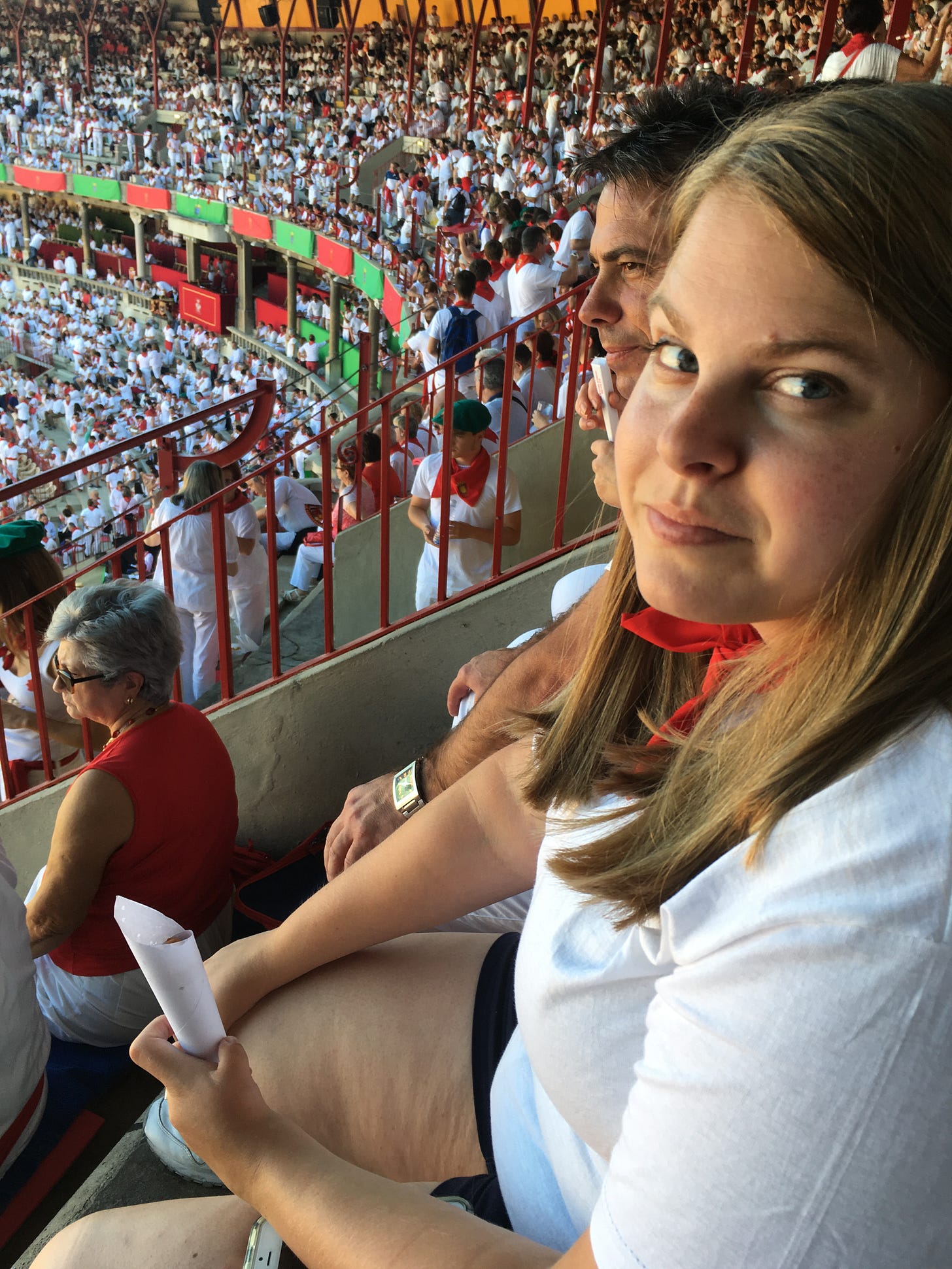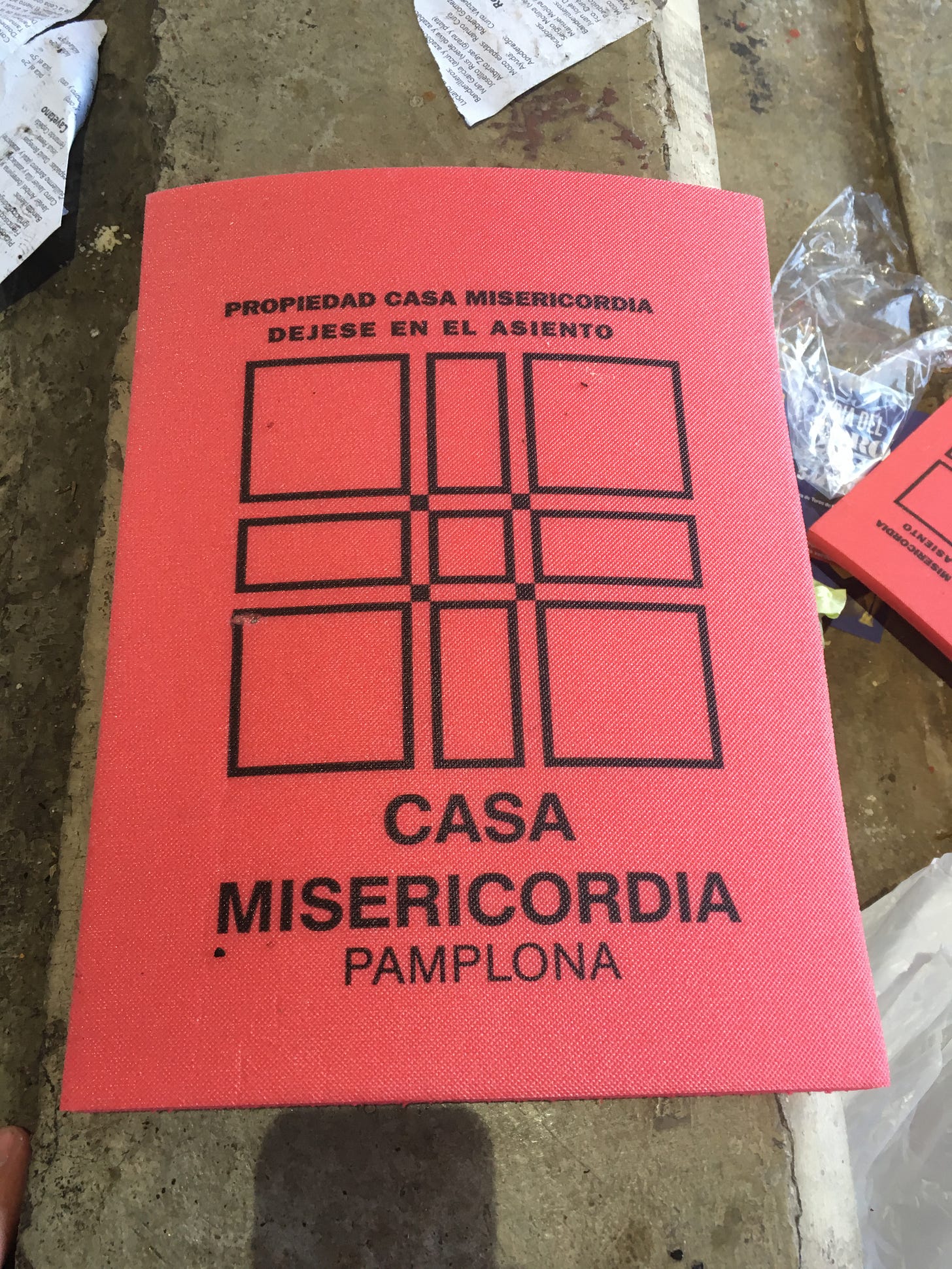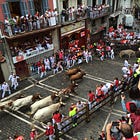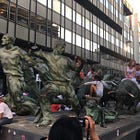Toros & Tubas: The Bullfight
Disclaimer: This story has pictures and descriptions that may make some people uncomfortable.
“So far, about morals, I know only that what is moral is what you feel good after and what is immoral is what you feel bad after and judged by these moral standards, which I do not defend, the bullfight is very moral to me because I feel very fine while it is going on and have a feeling of life and death and mortality and immortality, and after it is over I feel very sad but very fine.”1
- Ernest Hemingway
Before we left our lodging, we grabbed a corkscrew. We had gotten a tip that there are no food or beverage restrictions at the Plaza de Toros and it is expected that the spectators pack a meal. And a meal in Pamplona needs a corkscrew. We found a food stand that accepted cards and ordered two jamon iberico sandwiches and a bottle of wine to go. The meal for two cost us 13 euros.
We arrived well in advance of the start time stamped on our flimsy paper stubs, but the drunken pep bands had beat us to the ring. They had already started doing what drunken pep bands do: play drunken pep band music. Drunken pep band music that would not cease until they later stormed the arena floor and paraded out the stadium to bless all rural Spain with their beautiful drunken pep band serenades. But the night was still young. There were still too many things alive. Over the singing, whistling, and tubas, we heard a vendor crying out to potential customers from the aisle. He was holding a basketful of Marcona almonds with a metal scoop speared into the center of his pile of legumes. Paige wanted some, so we flagged down the almond man and used our meager pocketful of coins to purchase a single serving of almonds for 3 euros. The nut peddler fashioned a tube out of a piece of paper, expertly manipulated his scoop to slide in the perfect portion of almonds, and passed them down our row to my anxious wife.
Despite the rambunctious atmosphere, our seat mates were nothing but hospitable. As a Nebraskan, being kind to newcomers at sporting events is a source of pride for our people. On the walls of Memorial Stadium reads the inscription “Through these halls walk the greatest fans in college football” above each entryway. We make it a point to be nice to road teams, unless that road team is the Colorado Buffaloes, in which case they can go fuck themselves. Otherwise, sporting event hospitality is a matter we take seriously. The same can be said of our bench mates at the Plaza de Toros. Presumably, the person Yvette called to peddle their bullfight tickets was a family. Families don't sit next to the beer buckets and pep bands. In a bull ring, your ticket price is dependent on the amount of sun your seat is expected to endure. The spirit section is in direct glare from the first bull to the sixth, but we were seated “en la sombra,” along with all the other civilized patrons. No one was throwing beer bottles or slurring their words next to us, they were there to appreciate the artform. And they appreciated it deeply. Respectfully. As the parade of matadors and their entourage signaled the beginning of the evening, they were sure to pay their respects.
•••
“At this point it is necessary that to see a bullfight. If I were to describe one it would not be the one that you would see, since the bullfighters and the bulls are all different, and if I were to explain the possible variations as I went along the chapter would be indeterminable… So with any book on mountain-ski-ing, sexual intercourse, wing shooting, or any other thing which it is impossible to make come true on paper… there comes a place in the guide book where you must say do not come back until you have ski-ed, had sexual intercourse, shot quail or grouse, or been to the bullfight so that you will know what we are talking about.”2
- Ernest Hemingway
The matadors for the evening were Miguel Angel Perera, Cayetano Rivera, and Roca Rey. The six bulls came from the Jandilla ranch in Merida of the Badajoz province in Spain.
A bullfight has four parts:
1.
A matador isn't a one-man show, but rather a grand finale. A bullfight is a choreographed process of gradually wearing down a bull so that the matador can do some fancy tricks at the end before killing the beast once and for all. To accomplish this goal, he employs a stable of partners paid a meager salary, and each helps wear the bull out so that the matador can look fancy and in control at the end. A lot of these role players are wannabe matadors, up and comers given an entry level in the bullfighting career path. They have either failed to rise in the ranks or are waiting their opportunity to branch out on their own, recruit their own posse, and seek fame and glory as a bull killer.
The first step in tiring a bull is to get him to run around a whole bunch. When a fresh bull is released into the ring, he is understandably confused and royally pissed off. This has been a really fucking weird day so far, and he's had enough. As such, the behemoth is full of energy and in a mood that can only be remedied by running into something and letting everyone know just how unsatisfied he has been with his experience thus far.
A bullfighting bull is chosen at a young age. Ranches breed cattle for the purpose of providing toros for the fights, and like a Kentucky thoroughbred, their lineage has been refined over generations to breed and train the ideal creature for this esoteric purpose. To preserve their vigor and shitty disposition toward the world, a bull calf is tested early in life for his physical and emotional attributes. They are briefly shown a cape and their reactions are studied. If a rancher is satisfied with the bull’s response, he declares “Toro,” and the bull is separated from the herd. From there he is groomed for the rest of his life toward his ultimate demise in the ring. If the bull isn't enough of an asshole, he is castrated and lives out his life as a steer. I'm not sure which one has it better.
The bull is never shown a cape again until he enters the bull ring for the final time. Bulls are constantly pissed off, but they are smart. After a while, they start to figure out that all their sprinting and charging isn't yielding the desired results and will learn to aim straight for the human and not a floating piece of fabric. When the toro makes his big debut, enough time has passed to where he has forgotten what a cape is entirely.
The matador’s posse starts to work the bull with pink and yellow capes. When the animal first bursts out of the gate and into the open space of the ring, he is at full steam. The matador’s crew positions three or four men around the circumference of the ring and they fan out their capes with both hands to attract the animal's charge. When it's close, the men jump behind a wooden barricade before the bull gores him with his horns and another man tries to get the bull's attention. It's kind of like playing frisbee back and forth with your buddy while the dog chases the disc, except the dog is trying to kill you.
2.
While the bull is still getting worked by all the capes, two guys on horses slowly creep into the ring. The horses look like they're wearing Pac-man costumes. Horses, understandably, don't like bulls—so their eyes are covered in blinders and their bodies are cloaked in thickly woven yellow protectors. Riding on top are the picadors. Their yellow, flamboyant outfits match the color scheme of the horse jackets, but they stand out from all the others in the ring by carrying an enormous spear and wearing a cool cowboy hat. They stand and wait, allowing their homies to keep tiring the bull, until the bull gets just…close…enough…and…
BAAAMMM!!!!!
The picador jabs his pike square into the back shoulder of the bull. The bull really fucking hates this part.
Each bull gets speared twice over the course of the bull fight. The horses appear unharmed, but traditionally this was the most gruesome part of the bullfight and the one that upset the most visitors. Since my entire bullfighting fandom has been limited to a single evening, I’m hardly an authority on the subject. But Ernest Hemingway was. According to old Ernie, back when he watched bullfights it was common to see the bull kill the horse there on the spot. More than common, pretty much expected. The protective covers weren't added until later, but Ernest thought they were actually worse for the horse because the damage is done internally when a bull rams the steed, thus making it easier to ignore. The same horse can be trotted out time and time again for more and more abuse while their insides were being scrambled. The goal of a horse doctor was to simply keep the horses going, so sometime they would even fill up wounds with sawdust, stitch them back up, and send them back out to get maimed again. When a bull’s horn would pierce a surgically repaired spot, sawdust could be seen leaking out from the animal like a sandbag with a hole in the bottom.
I think horse protection technology has improved since Hemingway's day.
3.
After he has been freshly speared in the back— twice— the bull starts showing signs of weary. He has been unsuccessfully sprinting up to this point but has started in at a trot. No less furious, likely even more so, but the dude is worn out. He needs to be more calculated with his movements as his energy wanes. And now his back is bright red with blood that has begun to seep out of each of his wounds. Unfortunately, he isn't done with abuse for the evening.
The horses retreat to their stables, hopefully with all their internal organs intact. The picadors job is over, next in line are the banderillos. The banderillos use banderillas. There are no female banderillos, so the feminine “a” at the end of the word doesn't denote a girl banderillo, but rather a long pointy stick with hooks on the end. Once the bull has been poked twice and is tired of chasing flapping pieces of fabric, a banderillo comes out of the ring in a skipping, sort of hopping, trot with one pointy stick in each hand. He holds the pointy sticks at the tail, the non-pointy side, and extends both arms above his head in the Karate Kid crane position. He gets the bull’s attention… runs straight at the dwindling animal… and…
BAAAMMM!!!!!
The shitty banderillo sticks both banderillas in the back shoulders of the bull where the fishhook barbs trap it under the bull's flesh, leaving the banderillas dangling from his flaps of skin. The bull fucking hates this part too. The banderillos go another round, placing four banderillas in total. According to Hemingway, sometimes they go six. By the time this round is over, the bull is a bloody, crimson, pin cushion.
4.
Now that the bull has been made a shell of its former self by the matador’s poorly paid employees, the hero can trot out to receive all the glory. By trot, I mean walk dramatically. Hemingway makes it very clear that a matador should never run, he is the slow-motion superhero that can’t undignify himself by pretending like he’s scared or in a hurry to get out of a confined space with a bloodthirsty animal. It helps that the bull is already half dead, but still. His posse doesn't just do all the hard work tiring out the bull for him, earlier in the day a few people from each matador team go down to the bullring to inspect each of the six bulls and negotiate which two their boss will fight. There are certain temperaments that play better for a matador, put on a good show, and keep him out of as much danger as possible. Usually, each matador gets one good bull and one not-so-good bull, and after the determination is made, the picador or banderillo will report back to their matador and help strategize on the plan of attack for their particular bulls like a caddie would help the golfer read the greens.
The matador has three tools: a cape, a muleta, and a sword. The cape is of the same style used earlier, it's an actual cape worn on the shoulders that is handled with both hands with long, swoopy, strokes.
But what most people picture when they think of a matador is not the cape, it’s the red piece of fabric that he manipulates with a single hand called a muleta. There's less fabric, which allows for more aggressive movements and quicker tricks. And it's real handy to hide a sword in.
After some passes where the matador gets close to the bull as it charges, it becomes clear that the constant sprinting and dramatic loss of blood has put the bull near death's door. His stomach fills and drops with each deep breath and the blood has turned a tapestry of colors as some has dried on its back and more has leaked from the six holes yet to clot. When the matador feels the bull is ready to be finished off, he slowly walks to the side of the ring, takes the sword from a member of his staff, the whole crowd shushes one another, and for the first time the tuba players shut the fuck up. The bull goes in for on last charge as the matador has the sword drawn, pulled back above his head with the blade pointed straight at its target. The bull charges… the matador strikes… and…
BAAAMMM!!!!!
For a moment the bull and the matador become one.
After a long fight, the bull drops dead. The crowd yells “Ole!” and tubas proceed in fortissimo.
The matador walks over to the dead bull, cuts off its ear as a trophy (occasionally gifting it to a young woman he has plans of piercing in a different way after the bullfight) and then slowly circles the rings as the crowd cheers, throws him flowers if he is good, and throws shit at him if he was bad. Meanwhile stadium workers hitch the carcass behind a team of mules and drag the conquered foe out through the Zamboni door of the bullring. While the matador receives his praise, the only sign of the bull is the streak of blood left in the sand.
•••
“Nobody ever lives their life all the way up except bullfighters.”3
-Ernest Hemingway
After a bull is killed, the crowd yelled, “OTRA, OTRA!” presumably because they enjoyed the experience and wanted another one. Or maybe we just didn't understand what they were saying. There were a lot of moments like that. Luckily, the affluent families who could afford seats “en la sombra” were good neighbors. After the third bull was dead and the crowd’s cheers had subsided, EVERYONE stopped what they were doing and took out the food they brought. Paige and I still had our bottle of wine and jamon iberico sandwiches at our feet, so we took our cue. With every hor d'eourve pulled out from the Mary Poppins picnic bag of the family seated to our right, we were offered to partake. Skewers of olives, slices of cheese, and chocolates were all passed out to family members— and then the couple in front of us handed us a tin of cookies. We had nothing to share, but they knew we had no idea what we were doing. We were guests.
The seats were concrete benches, and everyone was handed a foam pad to cushion your butt cheeks for the three hours of entertainment. Printed on each pad was the name of the Plaza de Toros that I never saw used anywhere else: Casa Misericordia. Mercy House. These were the same red pads that I had seen tossed into the bullring the night before when we stumbled into the end of the last bullfight. After a while, the thin cushion’s effectiveness wears off, and frankly the first five bullfights were almost identical. I was still appreciative of the experience, but after watching the same thing five times in a row, even grisly animal slaughter can grow tiresome.
But all that changed with the sixth and final bull of the night.
This bull was familiar. As my butt had started to fall asleep on one side from sitting for so long on a concrete bunch, it woke up when I saw a brown bull run into the ring with a number 33 branded on his torso. He was ready to Fuck. Shit. Up. This bull was different. The way he moved. The way he used his horns. The speed that he ran. It was clear that he had been identified earlier in the day as the “best bull” and saved for last.
He took his abuse from the picadors and banderillos, but he seemed less effected by the torture than the previous five bulls. By the time the matador slowly walked to the center of the ring, 33 was still full of piss and vinegar. And wanted to show it. We had seen this matador work once already, but with 33 he had the bull mannerisms he needed to really put on a show. The muleta passes were closer and swifter, and the flurry of cape movements were theatrical. As 33 tired, the matador got to work. He stared down the bull, dramatically turned on the balls of his feet, and with his back to the bull he held up his hands for the crowd to cheer. When he turned back around, the bull hadn’t moved.
The matador walked straight to the bull's horns, placed his muleta behind his back, thrust out his hips, and inched toward the bull—matador crotch first— until his pelvis was well within range of being gored by the horns. Even though 33 had been the most aggressive bull both at the encierro and throughout the bullfight— the matador appeared in complete command. He knew what the bull was thinking. How he would react. How he would charge. How he would tire. How he would die.
The matador decided the bull was ready. He was handed the sword and the crowd hushed. Sword behind his head… 33 charged… and…
TWAANNNGGG!!!!!
For the first time all evening, a new sound entered the stadium. It was sharp. Piercing. Metallic. When the matador went in for the kill and his sword was stuck behind the bull's shoulder, 33 flung his head back and snapped the sword in half. The matador, holding the stump of his former blade, was tossed into the air as the bull charged him. The matador's team quickly ran in with their pink and yellow capes and distracted 33 to get him away from their fallen boss. The matador stood up, walked a few paces back toward the bull, and collapsed.
Two men ran to the matador, slung an arm across each of their shoulders, and dragged their injured boss through the tunnel where a team of mules had already carted off five bodies throughout the night. One of the other matadors came out to finish the job. There was little showmanship, just focus. When a second sword was thrust through his back shoulder, 33 fell.
I knew it was inevitable for the bull to be defeated, but I have to admit, I was rooting for him.
And then Paige and I went to watch fireworks.
To Be Continued.
Death in the Afternoon by Ernest Hemingway, pg. 4
Ibid. pg. 63
The Sun Also Rises by Ernest Hemingway, pg. 17










